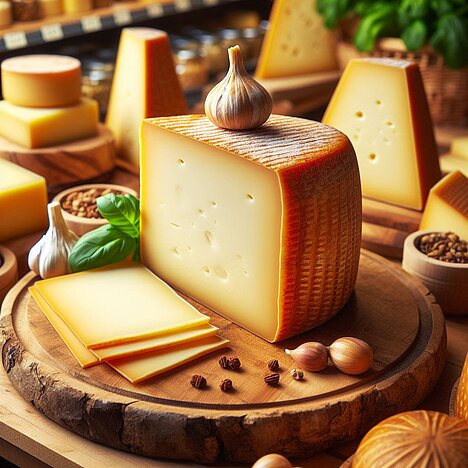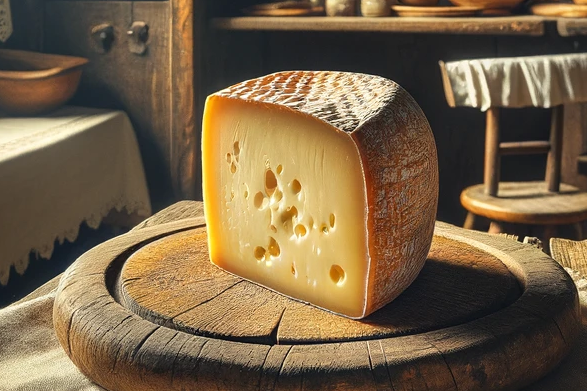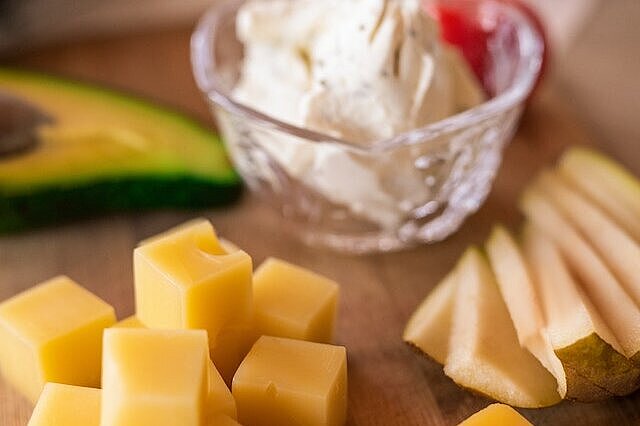Gruyère

Gruyère is a popular cheese from Switzerland that is known for its nutty and tangy flavor. But is it also suitable for dogs? In this article, you will find out what Gruyère is, how it is made and what advantages and disadvantages it has for your four-legged friend.
What is Gruyère?
Gruyère is a hard cheese made from raw cow's milk. It comes from the canton of Fribourg in Switzerland and is named after the town of Gruyères. It has had a protected designation of origin (PDO) since 2013 and may only be produced in certain regions of Switzerland.
To produce Gruyère, the milk is heated in large copper vats and curdled with rennet. The resulting curd is cut into small pieces and heated further to separate the whey. The curds are then pressed into molds and placed in brine. The cheese is then rubbed with bacteria and matured for at least five months. During this process, it develops its typical aroma through propionic acid fermentation, which is also responsible for the small holes in the cheese.
Gruyère has an ivory to light yellow color and a firm, grainy rind. It has a fat content of 47 to 52 % in dry matter and a salt content of 0.6 to 1.7 %. Depending on the ripening time, it can have a mild to strong flavor. It is well suited for gratinating, melting or as a table cheese.
Is Gruyère healthy for dogs?
Cheese is generally not an unhealthy food for dogs, as long as it is fed in moderation. It contains plenty of protein, calcium and other nutrients that are important for dogs' health. However, cheese also has some disadvantages that you should consider before giving Gruyère to your dog.
Benefits of Gruyère for dogs
- Gruyère can serve as a treat or reward for your dog, for example during training or as a hiding place for medication.
- Gruyère can promote your dog's dental health by removing plaque and massaging the gums.
- Gruyère can support your dog's digestion by providing probiotic bacteria that promote intestinal balance.
- Gruyère can strengthen your dog's immune system by producing antibodies that protect against infections.
Disadvantages of Gruyère for dogs
- Gruyère has a high fat and salt content, which can lead to obesity, high blood pressure or heart problems in your dog.
- Gruyère can contain lactose, which some dogs cannot tolerate well. This can lead to diarrhea, bloating or vomiting.
- Gruyère can trigger allergies or intolerances in your dog if he is sensitive to dairy products. This can manifest itself in skin rashes, itching or breathing difficulties.
- Gruyère may contain mold, which can be toxic to your dog. This can lead to symptoms of poisoning such as convulsions, tremors or unconsciousness.
How much Gruyère can my dog eat?
As with all foods, the same applies to Gruyère: the dose makes the poison. If you give your dog a small piece of Gruyère as a treat from time to time, this is usually not a problem. However, you should make sure that you limit the total amount of cheese your dog gets per day. As a rule of thumb, cheese should not make up more than 10% of your dog's daily calorie intake.
To find out how much Gruyère your dog can eat, you first need to know how many calories your dog needs per day. This depends on various factors, such as your dog's age, weight, activity level and state of health. You can make a rough estimate using the following formula:
Calorie requirement per day = 30 x weight in kg + 70
For example, if you have a 10 kg dog, it needs around 370 calories per day. Of this, no more than 37 calories should come from cheese. Since Gruyère has about 413 calories per 100 g, that's about 9 g of Gruyère per day for your dog. That's about a teaspoonful.
Of course, this calculation is only a guide and may vary depending on the individual dog.
Gruyère is a delicious cheese from Switzerland that can also be suitable for dogs, as long as it is fed in small quantities. It has some health benefits for dogs, such as promoting dental health, digestion and the immune system. However, it also has some disadvantages, such as high fat and salt content, lactose intolerance, allergies or mold. Therefore, you should always make sure that you don't give your dog too much Gruyère and observe his reaction.
If you notice any signs of hypersensitivity or poisoning in your dog, you should see your vet immediately. We are not a substitute for a vet, but we try to be as accurate as possible. Every dog reacts differently and we recommend you get a second opinion or consult your vet if in doubt.
Stay healthy and take good care of your four-legged friend!😊
Similar to Gruyère
Fontina is a traditional cheese from the Aosta Valley, an alpine region in north-western Italy. Since the 18th century, it has been made according to a fixed recipe from the whole raw milk of cows...
Raclette is a semi-soft semi-hard cheese made from cow's milk, originally from Valais in Switzerland. It has a mild to spicy taste and a creamy consistency. The name raclette comes from the French...
Appenzeller cheese is a semi-hard cheese (or semi-hard cheese) made from raw milk. It comes from the Appenzell region in north-eastern Switzerland, where it has been produced according to...
Beaufort is a hard cheese made from raw cow's milk. It comes from the east of the department of Savoie and two neighboring municipalities in the department of Haute-Savoie in the French Alps. The...



